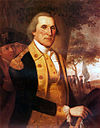Our website is made possible by displaying online advertisements to our visitors.
Please consider supporting us by disabling your ad blocker.
American gentry
This article needs additional citations for verification. (March 2024) |
The American gentry were rich landowning members of the American upper class in the colonial Southern United States.


The Colonial American use of gentry was not common. Historians use it to refer to rich landowners in the South before 1776. Typically, large scale landowners rented out farms to white tenant farmers. North of Maryland, there were few large comparable rural estates, except in the Dutch domains in the Hudson Valley of New York.[1][2]


The families of Virginia (see First Families of Virginia) who formed the Virginia gentry class, such as General Robert E. Lee's ancestors, were among the earliest settlers in Virginia. Lee's family of Stratford Hall was among the oldest of the Virginia gentry class. Lee's family is one of Virginia's first families, originally arriving in the Colony of Virginia from the Kingdom of England in the early 17th century. The family's founder was Richard Lee I, Esquire, "the Immigrant" (1618–1664), from the county of Shropshire. Robert E. Lee's mother grew up at Shirley Plantation, one of the most elegant homes in Virginia. His maternal great-great grandfather, Robert "King" Carter of Corotoman, was the wealthiest man in the colonies when he died in 1732.[3] Another prominent Virginia Family, related to both the Lee's and Carter's were the Tayloe's of Mount Airy, which they still own today. William Tayloe (planter) first arrived in Virginia before 1638 and John Tayloe II became the wealthiest planter in Virginia, the wealthiest colony.


Thomas Jefferson, the patron of American agrarianism, wrote in his Notes on Virginia (1785), "Those who labor in the earth are the chosen people of God if He ever had a chosen people, whose breasts He has made His peculiar deposit for substantial and genuine virtue." Jefferson who spent much of his childhood at Tuckahoe Plantation was a great-grandson of William Randolph, a colonist and land owner who arrived in Virginia from England in the mid-17th century. Randolph played an important role in the history and government of the English colony of Virginia.
George Washington was a commercial farmer interested in innovations, and quit his public duties in 1783 and again in 1797 to manage his plantation at Mount Vernon. Washington lived an upper-class lifestyle. Like most planters in Virginia, Washington imported luxury items and other fine wares from England. He paid for them by exporting his tobacco crop.
Extravagant spending and the unpredictability of the tobacco market meant that many Virginia planters' financial resources were unstable. Thomas Jefferson was deeply in debt when he died, and his heirs were forced to sell Monticello to cover his debts. In 1809, Henry Lee III, Robert E. Lee's father, went bankrupt and served one year in debtors' prison in Montross, Virginia; Robert was two years old at the time.[4][5] Despondent and nearly broke, William Byrd III of Westover Plantation committed suicide in 1777.
Wood notes that "Few members of the American gentry were able to live idly off the rents of tenants as the English landed aristocracy did."[6] Some landowners, especially in the Dutch areas of Upstate New York, leased out their lands to tenants, but generally—"Plain Folk of the Old South"—ordinary farmers owned their cultivated holdings.[7]
- ^ Ruggiu, François-Joseph (2008). "Extraction, wealth and industry: The ideas of noblesse and of gentility in the English and French Atlantics (17th–18th centuries)". History of European Ideas. 34 (4): 444–455. doi:10.1016/j.histeuroideas.2008.08.007.
- ^ Schlesinger, Arthur M. (1962). "The Aristocracy in Colonial America". Proceedings of the Massachusetts Historical Society. 74: 3–21. JSTOR 25080556.
- ^ Douglas Southall Freeman, R. E. Lee: A Biography (1934) online ch 1
- ^ A Princeton Companion (Lee, Henry), 1978, archived from the original on June 2, 2010, retrieved August 20, 2010
- ^ Stratford Hall/Lee Family Tree: Henry Lee III, archived from the original on June 2, 2010, retrieved August 20, 2010
- ^ Gordon S. Wood (2011). The Radicalism of the American Revolution. Knopf Doubleday. p. 113. ISBN 9780307758965.
- ^ Bolton, Charles C. (2005). "Planters, Plain Folk, and Poor Whites in the Old South". In Ford, Lacy K. (ed.). A Companion to the Civil War and Reconstruction. Malden: Blackwell. pp. 75–93. ISBN 0-631-21551-4.
Previous Page Next Page


